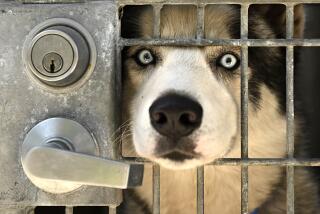No more curtain calls for elephants
The Los Angeles City Council is poised to consider a measure that would in effect prevent elephants from performing in traveling shows and exhibitions in the city. It’s hardly unusual for the council to sound off on any issue under the sun, but in this case, the proposal before it underscores a growing appreciation for the world’s largest and most majestic land mammal. It deserves to be approved, and should prompt serious reflection on humanity’s relationship with these noble animals.
In the wilds of Asia and Africa, elephants roam miles a day, foraging for vegetation, socializing in groups, gamboling over varied topography — dirt, grass, hills, rocks — and wallowing in mud holes. Until recently, nothing about that natural existence was approximated in zoos. When they weren’t on display in cramped exhibits, they were chained in zoo barns, standing on concrete or other hard surfaces. For 8,000-to-10,000-pound creatures who spend all day on their feet and can live into their 40s, the consequence of that confinement was a painful middle age, marked by arthritis, cracked toenails and sore feet.
Zookeepers entered elephants’ enclosures and maintained control over the animals with the bullhook. With one blunt end and a sharp hook on the other, it resembles a hammer. Keepers used it to poke, prod or strike.
Since the 1990s, as zoos and veterinarians started to understand the severity of elephant foot diseases, conditions began to improve. Zoos stopped chaining their elephants at night. Exhibits got bigger and surfaces for treading got softer. The Los Angeles Zoo spent more than $40 million building a new habitat, trying to offer, in several acres, some of what elephants might find in the wild — dirt, grass, hills, logs, a waterfall— as well as features they wouldn’t find, such as a barn with heated floors.
Today at the L.A. Zoo, the bullhook has been banished and keepers practice “protected contact” with elephants, meaning that man and pachyderm rarely share the same space. This protects keepers and animals and eliminates the need for the former to threaten the latter with a sharp-edged tool. The Assn. of Zoos and Aquariums, which accredits North American zoos, has instructed all of its member facilities to adopt, by 2014, the practice of keepers not sharing “unrestricted space” with elephants.
What has been slower to change is the common perception of elephants and how they interact with human civilization. That concept is tangled in a history of pachyderms depicted as brave warriors in battle, stately beasts of burden and hardy workers, hauling lumber in Asia, ferrying tourists in Thailand and carrying visitors at county fairs in the United States.
But elephants are not horses. Although some argue that they have become domestic animals, they are not domesticated in the technical sense of having been bred by humans for selective gene traits. At best (or worst), many have been tamed for human handling. But “taming” is not gentle; it requires chaining and the bullhook, and comes at the expense of an elephant’s well-being. Whether the animal is trained to entertain or to drag logs through a jungle, it is taught by force.
Using elephants to perform in circuses and give rides at county fairs may seem more benign than using them to labor in Asian logging facilities, but it relies on much of the same coercion. Ringling Bros. and Barnum & Bailey Circus has long defended its use of elephants, saying they are meticulously cared for on the road and at its conservation center in Florida. But Ringling still chains its elephants in trains to transport them and uses bullhooks to manage them, according to reports by the L.A. Department of Animal Services and a veterinarian assigned by the department to examine the animals. That’s why a City Council committee is recommending a prohibition on public elephant performances and bullhooks.
Elephants have been part of human history for thousands of years, and their image as gentle giants endures. But their interaction with humans has often been characterized by their mistreatment. With greater understanding has come new responsibility to treat elephants with the dignity they deserve and have too often been denied.
More to Read
A cure for the common opinion
Get thought-provoking perspectives with our weekly newsletter.
You may occasionally receive promotional content from the Los Angeles Times.






